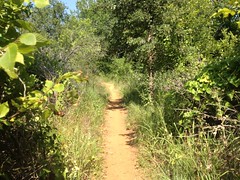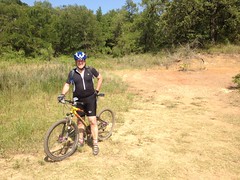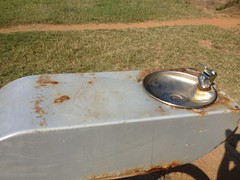Eddie's been trying to get me to drop by 55nine to get fit for years now. Years. Plural. I've always been a little conflicted because the shops I've ridden for do bike fits too and on top of that, there's always been some other, more pressing concern, but with back and neck pain still lingering from ORAMM (two years ago), and with my right knee trying to tear itself apart for the past few months, I figured now might finally be a good time.
I brought the Iz along, she took a bunch of photos and I kept the ones that had the greatest potential for personal embarrassment, and thus humor. She has a good eye for that, so I didn't have to delete too many.
I can't remember the details of what we were doing in every photo, nor am I sure whether what I do remember is proprietary intellectual property or not, so I'll relate what is probably OK to relate and make jokes about the rest.
Getting started...
I changed into my kit, Eddie felt all over me and drew a bunch of dots and lines with a permanent marker, then measured the distances between them.

I saw this movie once called "What Would You Say To a Naked Lady" by Alan Funt. Hilarious - basically an adultish version of Candid Camera. They had this whole bit about what tailors can get away with. People want their clothes to fit well. If their tailor doesn't feel them up pretty well, then they don't feel like he's doing a good job.
It was kind of like that. Not quite as awkward, but it reminded me of it and of course, Iz thought it was all very funny.
Next, I did some ballet. I think this is position 11: camionneur.

I made that up. What are there, 10 positions? 5 arm and 5 foot? Sophie would know. I'm actually not sure what we were doing there.
I like this shot because it's nothing but knees. Knees, knees, knees.

"36-24-36?"

"Only if she's five-three."
Next, I got into the birthing position...

I put that one on facebook. Oh man, the captions people came up with.
It was actually a pretty good back stretch though, I might start doing it at home sometimes.
Later Eddie took some measurements and traced my feet.

I figured he'd make a turkey out of it or something but he did something scientific on the computer instead.
Then there was a relaxing foot massage...

Followed by calculations...

And number crunching...

And measurements of my bike...

And Lasers!

Then we did a couple of the weirdest high-fives ever.

And then we got serious for a while.
The premise, as I remember it, is... If you angle everything right, you get the best power transfer possible, while simultaneously minimizing forces on the soft tissues of the joints and allowing each muscle to both work hard and rest well. If any of these angles are sufficiently off, you can get cascading, sometimes unintuitive problems that can lead to fatigue, pain and eventually injury, if you push it long enough, which I definitely have, from time-to-time. There's sort of a safe range of angles for everything to operate in, and there are formulas for optimizing power, aerodynamics, maneuverability, etc. within those ranges. So, you take bike and body measurements, plug them in to the formulas and out come seat height, bar reach, cleat position and so on, for whatever type of bike you're riding; road, mountain, tri, time-trial, etc.
It makes even more sense if you see examples of what's happening on skeletal models.

The measurement and calculation part really starts to make sense when you bend your foot or knee a certain way and he's like: "Do you feel that hamstring load up?" and I'm like "No, not really" but then he pushes on it and then you totally do feel it. My nerves aren't sensitive enough to notice it on their own though. So, there could be all kinds of subtle problems that I don't feel until the cumulative effects add up to fatigue, some time later and I have to back-derive what might have caused it. Normally though, I wouldn't even do that, I'd just figure I needed to get trained up a little more.
The whole process reminded me of being in a band in college. My brother John ran sound for us and when we'd set up the PA system in a bar for a show, he'd "tune the room" by running pink noise (all frequencies, rotating quickly and randomly, at the same volume) through the speakers and adjust the input to the amp with a third-octave equalizer until a real-time analyzer with a calibrated microphone attached to it said that all frequencies were at the exact same volume. Effectively, exactly what went into the mixing board went into the ears of the crowd and any "coloration" from the amps, speakers and room was cancelled out.
Most people didn't do this, they just fiddled with the EQ when they'd get feedback and relied on their ears to do the rest until they got a "warm" sound.
We didn't want a warm sound though, we wanted accurate sound, and we got it. On top of that, we got beautiful imaging and excellent separation between the instruments. We used less power to play louder without sounding "harsh" and you could point the mic directly at a cranked monitor, anywhere on stage and there was no chance of feedback. For that matter, the monitors didn't even need to be cranked. And it took far less time to do a sound check than "ringing out" the room by ear.
Most human ears aren't sensitive enough to achieve all that, but the RTA is and the results were impressive. John then went on to apply the same ideas to car audio and won competitions consistently, for years.
The bike-fit process reminded me of that room-tuning process. Both replace human senses with far more sensitive measuring devices, and the more Eddie explained about it, the better it sounded.
Science concluded, we got back to doing funny-looking things again.
Uh... What'cha got going on back there Ed?

"The angle of the dangle..." or something.

Since I was involved in this process, all things that could be difficult, were. Especially one of my cleat bolts.

While waiting for the drill to charge, we worked on the road bike.
I got some pointers on my stroke, from behind.

It was actually a little weird being on a trainer that long. I don't own one and the longest I've ever spent on one was warming up before each lap at the 24 Hours of Adrenaline way back.
Apparently, after a while, I started checking over my shoulder, maybe for cars, or for the attack...

The most immediately noticeable thing, and it was so noticeable that it made me really, really happy, was how different I felt "spinning up".

If I'm planning an attack or if a hill is coming then I "spin up" into it, shifting power, mainly to my hamstrings, but then shifting ASAP to my quads because my hamstrings would get weak, very quickly under load. Post-fit, that weakness doesn't come. My hamstrings just don't get weak. What the heck?! I can't wait to get out on the road for real with that.
The other immediately noticeable thing was that my knees didn't orbit. I've always had to think about keeping my knees from moving left and right as they rise through the pedal stroke, but now they don't appear to even want to. Nice.
When the drill was charged, Eddie drilled out that stuck bolt, adjusted my shoes, and fit the mountain bike too.

The road bike immediately felt great. The mountain bike immediately felt strange. I'm going to have to ride it for real though and see what's what. It's hard to tell on a trainer. Everybody else that I know that's ever been fit has had good results though, so I'm optimistic, if only I could get a ride in.
It's getting up to 104 in Atlanta these days, but I don't care about the heat, 104 is actually cooler than it's been in Texas. All the adjustments left me with short brake cables though, so the road bike's in the shop right now for that and I can't easily ride the mountain bike until Kathryn gets back from Baton Rouge.
Oh, normal life, when will you return?
When will you return!?

































